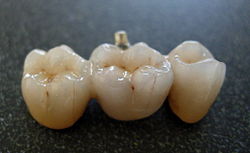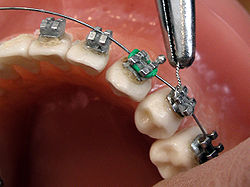Bridge
A bridge, also known as a fixed partial denture, is a dental restoration used to replace a missing tooth by joining permanently to adjacent teeth or dental implants. Types of bridges may vary, depending upon how they are fabricated and the way they anchor to the adjacent teeth. Conventionally, bridges are made using the indirect method of restoration. However, bridges can be fabricated directly in the mouth using such materials as composite resin. A bridge is fabricated by reducing the teeth on either side of the missing tooth or teeth by a preparation pattern determined by the location of the teeth and by the material from which the bridge is fabricated. In other words, the abutment teeth are reduced in size to accommodate the material to be used to restore the size and shape of the original teeth in a correct alignment and contact with the opposing teeth. The dimensions of the bridge are defined by Ante’s Law: “The root surface area of the abutment teeth has to equal or surpass that of the teeth being replaced with pontics“. The materials used for the bridges include gold, porcelain fused to metal, or in the correct situation porcelain alone. The amount and type of reduction done to the abutment teeth varies slightly with the different materials used. The recipient of such a bridge must be careful to clean well under this prosthesis.
When restoring an edentulous space with a fixed partial denture that will crown the teeth adjacent to the space andbridge the gap with a pontic, or “dummy tooth”, the restoration is referred to as a bridge. Besides all of the preceding information that concerns single-unit crowns, bridges possess a few additional considerations when it comes to case selection and treatment planning, tooth preparation and restoration fabrication.
The materials used for the bridges include gold, porcelain fused to metal, or in the correct situation porcelain alone. The amount and type of reduction done to the abutment teeth varies slightly with the different materials used. The recipient of such a bridge must be careful to clean well under this prosthesis.
When restoring an edentulous space with a fixed partial denture that will crown the teeth adjacent to the space andbridge the gap with a pontic, or “dummy tooth”, the restoration is referred to as a bridge. Besides all of the preceding information that concerns single-unit crowns, bridges possess a few additional considerations when it comes to case selection and treatment planning, tooth preparation and restoration fabrication. Bridge

A bridge, also known as a fixed partial denture, is a dental restoration used to replace a missing tooth by joining permanently to adjacent teeth or dental implants.
Types of bridges may vary, depending upon how they are fabricated and the way they anchor to the adjacent teeth. Conventionally, bridges are made using the indirect method of restoration. However, bridges can be fabricated directly in the mouth using such materials as composite resin.
A bridge is fabricated by reducing the teeth on either side of the missing tooth or teeth by a preparation pattern determined by the location of the teeth and by the material from which the bridge is fabricated. In other words, the abutment teeth are reduced in size to accommodate the material to be used to restore the size and shape of the original teeth in a correct alignment and contact with the opposing teeth. The dimensions of the bridge are defined by Ante’s Law: “The root surface area of the abutment teeth has to equal or surpass that of the teeth being replaced with pontics“.
The materials used for the bridges include gold, porcelain fused to metal, or in the correct situation porcelain alone. The amount and type of reduction done to the abutment teeth varies slightly with the different materials used. The recipient of such a bridge must be careful to clean well under this prosthesis.
When restoring an edentulous space with a fixed partial denture that will crown the teeth adjacent to the space andbridge the gap with a pontic, or “dummy tooth”, the restoration is referred to as a bridge. Besides all of the preceding information that concerns single-unit crowns, bridges possess a few additional considerations when it comes to case selection and treatment planning, tooth preparation and restoration fabrication.


 Dr. Olivia Loeblein grew up in Stoneboro, PA and graduated from Westminster College. She then went on to earn her dental degree from Case Western Reserve University where she was actively involved in the American Student Dental Association and PSI Omega fraternity. She is now back in Western PA and excited to be working close to home. Dr. Olivia enjoys reading, spending time outdoors, and musical theatre. She is currently involved in community theatre and is part of the worship team at church.
Dr. Olivia Loeblein grew up in Stoneboro, PA and graduated from Westminster College. She then went on to earn her dental degree from Case Western Reserve University where she was actively involved in the American Student Dental Association and PSI Omega fraternity. She is now back in Western PA and excited to be working close to home. Dr. Olivia enjoys reading, spending time outdoors, and musical theatre. She is currently involved in community theatre and is part of the worship team at church.



 and odous “tooth”) is the first specialty of dentistry that is concerned with the study and treatment of
and odous “tooth”) is the first specialty of dentistry that is concerned with the study and treatment of 
 tures are removable, however there are many different denture designs, some which rely on bonding or clasping onto teeth or
tures are removable, however there are many different denture designs, some which rely on bonding or clasping onto teeth or  branches that may connect the root canals to each other or to the surface of the root.The smaller branches, referred to as accessory canals, are most frequently found near the root end (apex) but may be encountered anywhere along the root length. There may be one or two main canals within each root. Some teeth have more variable internal anatomy than others. This space is filled with a highly vascularized, loose connective tissue, the dental pulp.The dental pulp is the tissue of which the dentin portion of the tooth is composed. The dental pulp helps complete formation of the secondary teeth (adult teeth) one to two years after eruption into the mouth. The dental pulp also nourishes and hydrates the tooth structure which makes the tooth more resilient, less brittle and less prone to fracture from chewing hard foods. Additionally, the dental pulp provides a hot and cold sensory function. Root canal is also a colloquial term for a dental operation,
branches that may connect the root canals to each other or to the surface of the root.The smaller branches, referred to as accessory canals, are most frequently found near the root end (apex) but may be encountered anywhere along the root length. There may be one or two main canals within each root. Some teeth have more variable internal anatomy than others. This space is filled with a highly vascularized, loose connective tissue, the dental pulp.The dental pulp is the tissue of which the dentin portion of the tooth is composed. The dental pulp helps complete formation of the secondary teeth (adult teeth) one to two years after eruption into the mouth. The dental pulp also nourishes and hydrates the tooth structure which makes the tooth more resilient, less brittle and less prone to fracture from chewing hard foods. Additionally, the dental pulp provides a hot and cold sensory function. Root canal is also a colloquial term for a dental operation,  plant
plant are placed within the bone (endo- being the Greek prefix for “in” and osseous referring to “bone”). The bone of the jaw accepts and
are placed within the bone (endo- being the Greek prefix for “in” and osseous referring to “bone”). The bone of the jaw accepts and 